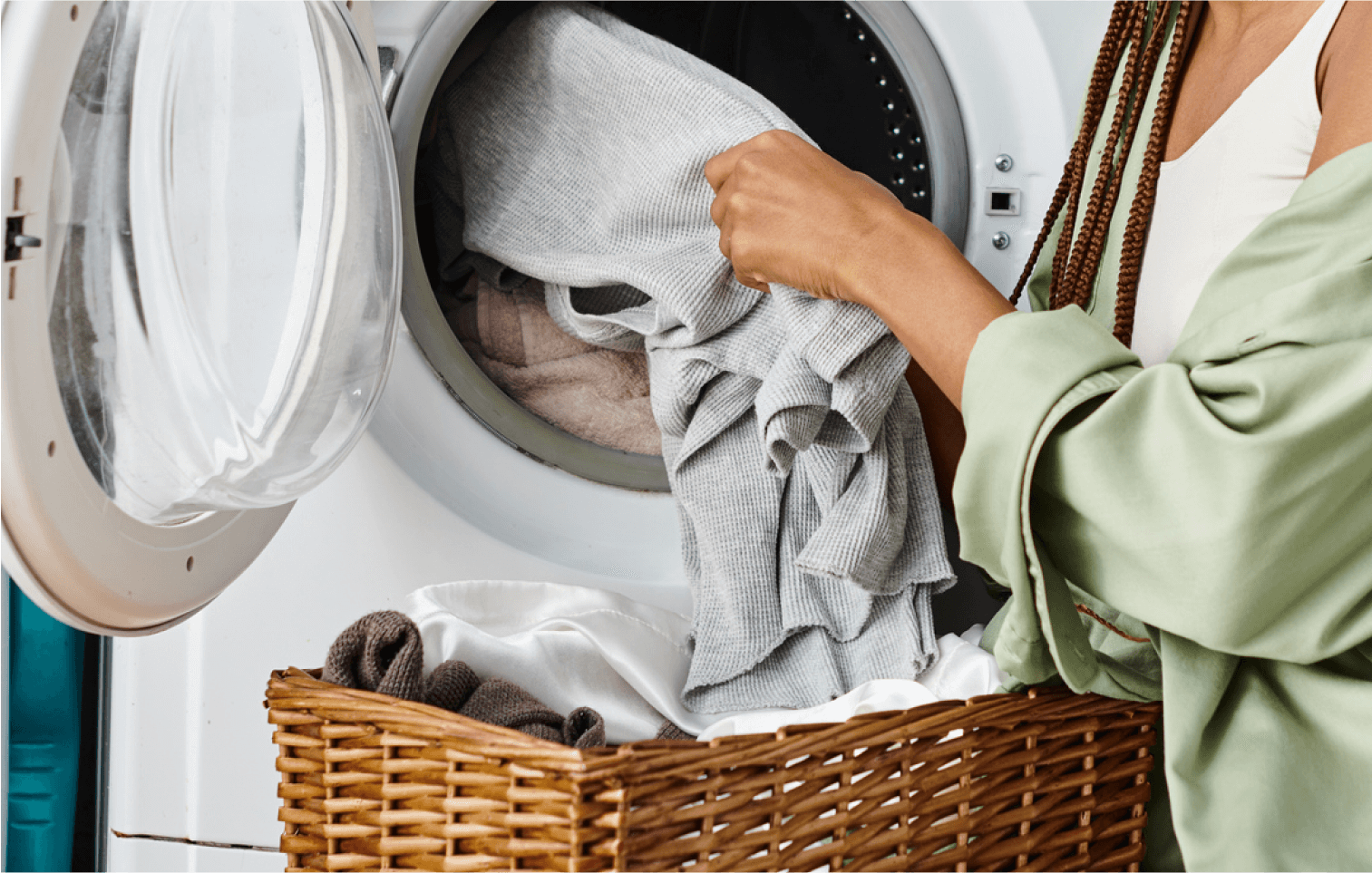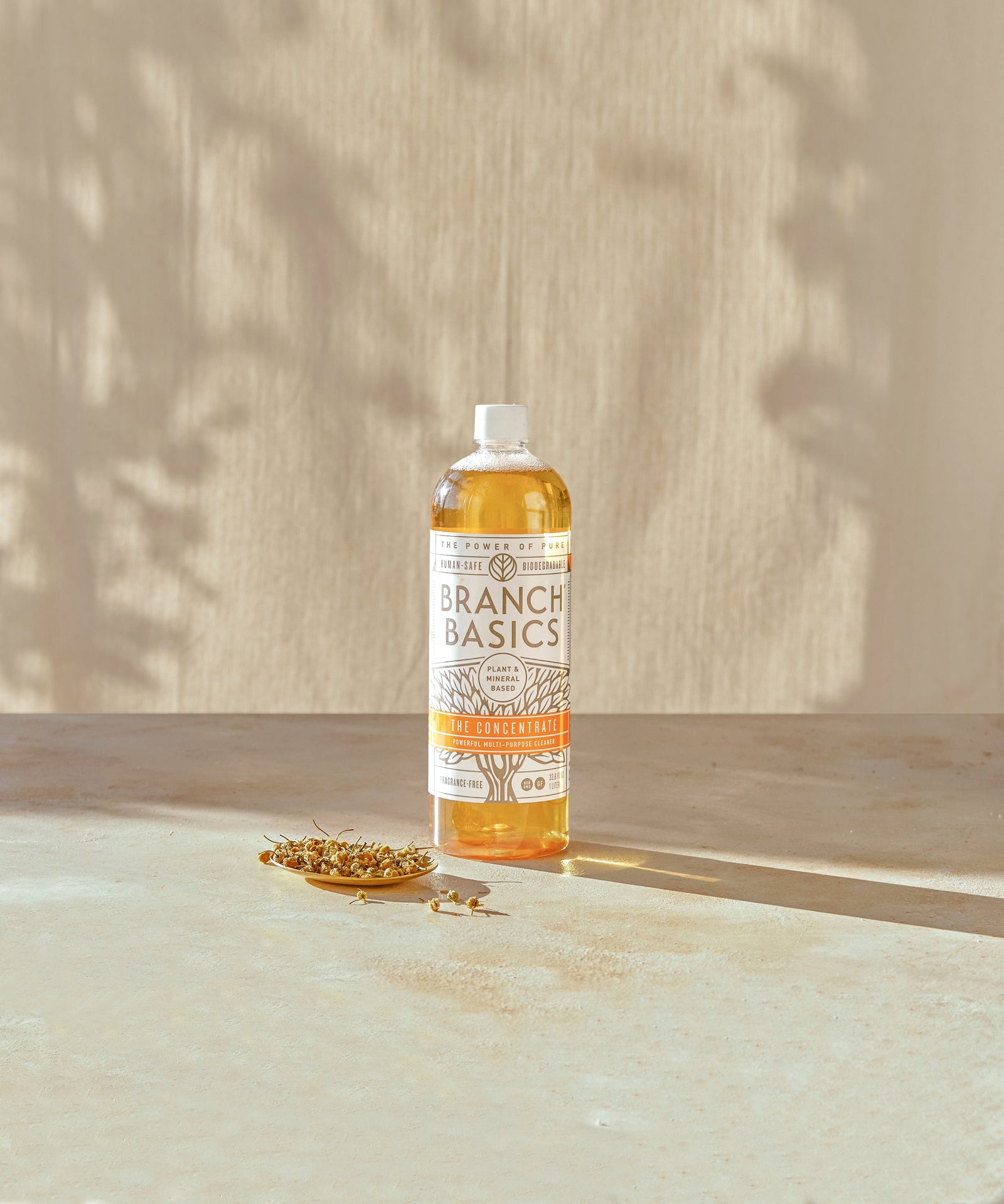Get Rid of White Residue on Your Clothes After Washing With These Tricks

White residue on clothes after washing is a frustrating laundry mystery just begging to be solved.
If you’ve ever opened the dryer and found your clothes peppered with white spots, streaks, or powdery patches, you know exactly what we’re talking about.
But, where did it come from? What caused it? How can you get rid of it? And, how do you prevent it from happening again?
At Branch Basics, we’re committed to helping you create a cleaner, healthier home—including your laundry room and routine.
In this article, we’ll share why white residue happens and the simple, human-safe, and effective tricks you can use to get rid of it for good.
What Causes White Residue?
Let’s start by looking at what causes white residue on clothes after washing them.
Surprisingly common, white residue is often caused by undissolved detergent, excessive lint, too much fabric softener, or minerals found in hard water.
Undissolved Detergent
Undissolved detergent, especially powdered formulas, is a common cause of white residue on clothes.
If the detergent doesn’t fully dissolve, it can leave behind white streaks and spots. This is usually due to too much detergent, adding detergent on top of the clothes instead of the bottom of the drum, and/or cold water temperature.
The type of washer you have can also affect how powdered detergents perform. High-efficiency (HE) washers require less detergent because they use less water, about 2 teaspoons per load. Using too much can cause that unwanted white residue.
For best results, always add powdered detergent, like Branch Basics Laundry Detergent, to the empty washer, never on top of the clothes!
Or, consider switching to a liquid formula like Branch Basics Laundry, made by combining our all-in-one Concentrate and water in the Laundry bottle.
If you’re still having issues with undissolved detergent, try one of these 10 Natural Laundry Detergent Alternatives That Actually Work.
Excessive Lint
New clothing and towels may shed excessive lint during the first few wash and dry cycles.
This is completely normal and will resolve itself over time. In the meantime, use a lint roller to remove any loose lint.
Too Much Fabric Softener
We don’t recommend using it because the chemicals found in fabric softeners are among the most toxic.
However, if you’re noticing white residue on your clothes after washing, you may be using too much fabric softener.
The conditioning agents in various fabric softeners can build up in clothing fibers over time, resulting in a white film that prevents laundry detergent from working properly.
The best course of action is to ditch this toxic laundry product and opt for a safer alternative.
On the hunt for safer and healthier alternatives to conventional fabric softeners that won’t leave white residue behind? Check out 7 Legit Natural Fabric Softener Alternatives.
Hard Water
The type of water you have in your home (ie, soft or hard) can affect how well your laundry detergent works and how clean your clothes get.
According to the United States Geological Survey[1], hard water contains high levels of calcium, magnesium, and other minerals that leach from rocks. These elements react with detergents, leaving mineral deposits or white residue on fabrics.
Learn more about The Impact Of Soft And Hard Water On Laundry and how to adjust your laundry routine accordingly.
Solutions For Getting Rid of White Residue On Your Clothes
Now let’s take a look at two solutions to help you get rid of white residue on clothes after washing: vinegar and Branch Basics Oxygen Boost.
Vinegar
Vinegar* is an effective, safe, and non-toxic stain remover for the laundry room. The acetic acid found in vinegar helps remove white residue from clothes by breaking down detergent and mineral buildup.
This method is excellent for use on undissolved detergent and hard water stains.
Here’s how to use vinegar to get rid of white residue on your clothes:
- Add 1 cup white distilled vinegar and 1 quart of water to a bucket or sink.
- Submerge the stained clothing and scrub the fabric to loosen the stains.
- Let soak for up to an hour.
- Wash the clothes in the hottest water suitable for the fabric. Do not add detergent or fabric softener. You can, however, add 1 cup of vinegar to the wash for extra stain-fighting power.
- When the wash cycle is complete, check the clothes for stains. If stains remain, repeat the process. If the stains are removed, the clothes can be moved to the dryer.
For more ways to use vinegar, check out 12 Ways To Use Vinegar In Your Home.
*Note: Although vinegar is safe, it is highly acidic and should be kept out of the reach of children and pets. If anyone in your home is sensitive to smells or has a respiratory issue, it’s best to not make vinegar or vinegar solutions airborne by spraying.
Instead, try dabbing or wiping it on, and keep the windows open for proper ventilation.
Oxygen Boost
Branch Basics Oxygen Boost is highly effective at removing laundry stains, including white residue.
It’s made with two biodegradable minerals: sodium bicarbonate, also known as baking soda, and sodium percarbonate, also known as oxygen bleach or powdered peroxide.
For stain removal, Oxygen Boost can be used directly with Branch Basics All Purpose or Laundry, or as a soaking agent*.
This method is excellent for undissolved detergent, fabric softener residue, and hard water stains (just make sure you use distilled water during this process if your tap water is already hard).
*Note: Always pretest fabrics in an inconspicuous area first to see how the material responds. Oxygen Boost can be used directly on white fabrics, while we recommend soaking colored fabrics.
Here’s how to use Branch Basics Oxygen Boost to get rid of white residue on your clothes:
- For white fabrics, sprinkle Oxygen Boost directly on the stain and spray with Branch Basics All Purpose. Let sit for 5-10 minutes.
- For colored fabrics, mix 1-2 teaspoons of Concentrate and ½-1 scoop of Oxygen Boost in a sink or bucket filled with enough water to cover the garments.
- Agitate until soapy, and let it sit for 5-10 minutes.
- If soaking, let soak for 15 minutes to overnight, depending on how tough or old the stain is.
- Rinse and repeat if necessary.
- When the stain is gone, wash in the washer without additional detergent.
Pesky stains are the worst! Check out How to Use Branch Basics For Laundry and our Stainmaster Guide for more tips and tricks.
How to Prevent White Residue
You’ve removed the white residue from your clothes, now let’s make sure it doesn’t happen again.
Here are a few simple tips to help prevent it in the future.
Try Out Different Washer Cycles
The first step is to try switching up the wash cycle. Doing so can help reduce stains by ensuring your clothes get the right balance of agitation, water temperature, water depth, and rinse time.
For example, heavier wash cycles, like heavy duty, deep water wash, and whites use more water and longer rinse times. This can help dissolve and rinse away detergent, fabric softener and hard water minerals.
On the other hand, gentler cycles like delicates and casuals won’t agitate the fabrics as much, reducing the chance of excessive lint or shedding.
Choose a Different Temperature
To prevent white residue, always make sure the temperature is at least 60 degrees or higher, especially if you’re using a powdered detergent.
Branch Basics Laundry Detergent is the exception, however. Our all-in-one powdered formula whitens, brightens, deodorizes, and lifts stains with just one scoop. It’s also powerful enough to use in cold or hot temperatures and is reliable in hard water settings.
Clean Your Washer
Yes, you read right, clean your washer to prevent white residue!
Without regular cleanings, detergent and mineral buildup can accumulate inside the machine.
Run a hot water cycle with vinegar to help dissolve buildup and prevent it from redepositing on your laundry.
Learn more in How To Clean And Detoxify Your Washer And Dryer.
H2: Can the White Residue Permanently Stain My Clothing?
No, white residue cannot permanently stain your clothing. Simply follow the stain removal processes here and rewash without detergent.
For more stain-fighting tips and tricks, check out The Top 7+ Natural & Reliable Laundry Stain Removers.
Fresher Laundry With Branch Basics
If you’ve been battling with white residue on clothes after washing, then we hope this article has given you useful tips and tricks to identify, treat, and prevent these stains safely and effectively.
Uplevel your human-safe laundry room and home with all-natural, safe, and effective products like Branch Basics.
Our all-in-one cleaning system can be used for stain removal, laundry, house cleaning, and more!
Check out Branch Basics Premium Starter Kits (available in refillable plastic or glass bottles).
Our kits have everything you need to remove any type of stain on clothing and carpets, clean your entire home, wash your clothes, and more. Each kit comes with a bottle of Concentrate, refillable bottles, and a full bag of Oxygen Boost.
All Branch Basics products are made with only the most gentle, human-safe, plant- and mineral-based ingredients. They are also MADE SAFE Certified, third-party tested as non-skin and eye irritants, and safe for the most sensitive individuals, including babies, pets, and the chemically sensitive.
Learn more about how the system works in How To Get Started With Your Branch Basics Kit.
Sources:

Marilee Nelson
Marilee Nelson is an Environmental Toxins expert who has spent nearly 30 years advocating for the chemically-sensitive and chronically-ill. She is a Board Certified Nutritionist, Certified Bau-Biologist and Bau-Biology Inspector and specializes in Food As Medicine. She has helped thousands of families and individuals identify, heal and recover from toxic exposures and is on a mission to revolutionize the way American families view their health.








